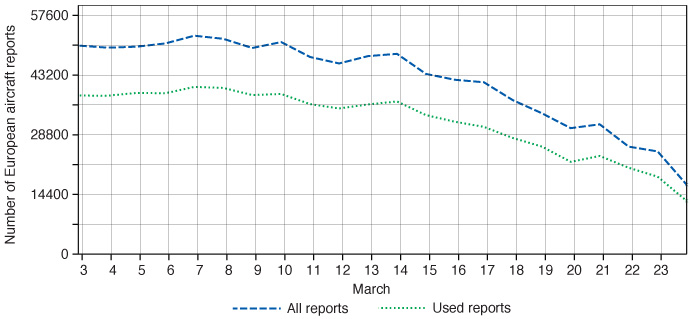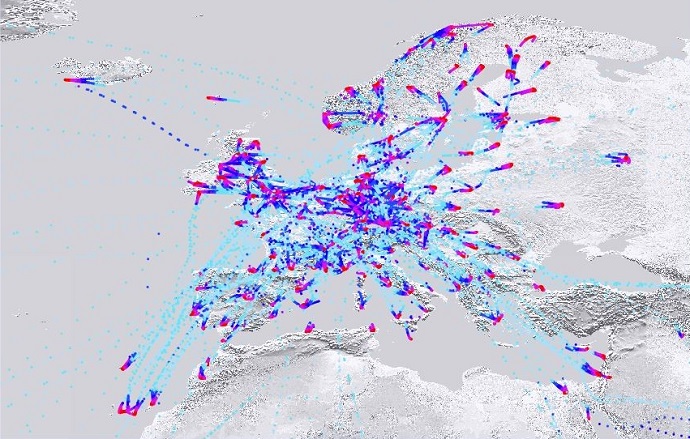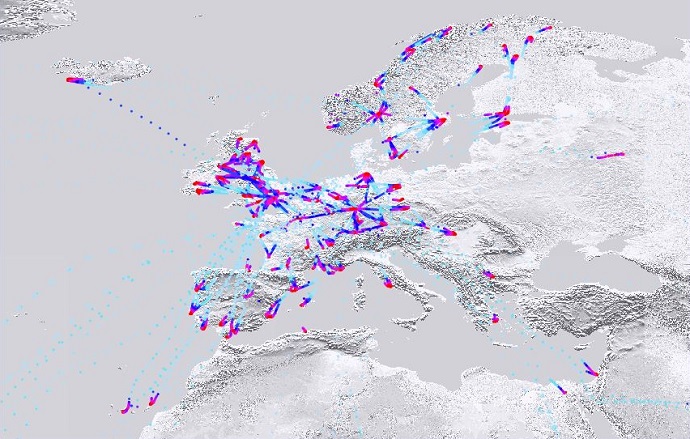The data that is plugged into the weather forecast models comes from radiosondes attached to weather balloons, from buoys, satellites, and aircraft. This includes commercial aircraft. One aspect of the COVID-19 pandemic has been a reduction in aircraft flights and thus of the aircraft-based observations available to weather forecast centres.
At ECMWF, aircraft reports are second only to satellite data in their impact on forecasts. However, recently added satellite wind observations will help to mitigate the drop in the number of aircraft-based observations.
The reduction
The image below shows how the number of aircraft-based observations over Europe received and used at ECMWF has evolved since the start of March.

Number of aircraft reports over Europe received and used at ECMWF per day. Some reports are not used because they are near-duplicates, and a small proportion are rejected as poor quality. By 23 March there was a reduction of 65% in reports received compared to 3 March. Globally the reduction was about 42%.
One of the main sources of aircraft-based observations (ABOs) in operational weather forecasting is the WMO’s Aircraft Meteorological Data Relay (AMDAR) programme. The following two charts illustrate how the reduction in flights has affected European AMDAR reports.


European AMDAR coverage for 2 March 2020 (top) and 23 March 2020 (bottom). Colours indicate the altitude, with red indicating low altitudes. There is a general reduction in report density, particularly over Italy and parts of Eastern Europe. (Figures courtesy of Stewart Taylor, EUMETNET)
Many aircraft reports are provided by US airlines, with particularly dense coverage over the USA, but European and other programmes also make significant contributions. European aircraft reports, which are co-ordinated by EUMETNET, were particularly badly hit last week, but other programmes have declined substantially in the last few days.
To reduce costs, AMDAR reports may be switched off where there are already plenty of aircraft reports. This gives some resilience to the overall number of observations.
“The latest information available from airlines suggests that European AMDAR coverage will be reduced by 65% or more over the coming month, which is currently expected to continue into the summer,” says Steve Stringer, EUMETNET ABO Programme Manager.
The numbers and geographical coverage are also expected to be reduced elsewhere over the coming weeks.
“We are anticipating the substantial reduction in the availability of US AMDAR data to continue over the coming weeks, likely to generate some measure of impact on the output of our numerical weather prediction systems,” says Christopher Hill from the US National Oceanic and Atmospheric Administration (NOAA).
The Australian AMDAR programme has been normal up to now. “However, this is expected to change significantly soon, with Qantas suspending all international flights from the end of March and reducing Australian domestic flights by 60%,” says Douglas Body, from the Australian Bureau of Meteorology (BoM).
A small proportion of aircraft reports come from cargo flights, which are less affected than passenger flights.
The impact of aircraft observations at ECMWF
In 2019 a test was run: a series of forecasts without using aircraft reports (but with all other data) to estimate the state of the Earth system, compared to using all data (i.e. including aircraft reports).
As illustrated in the figure below, the largest impacts on forecasts are centred around 250–200 hPa (about 11–12 km in height), which is a typical aircraft cruising altitude. Geographically the largest impacts are in the northern hemisphere for both wind and temperature.










